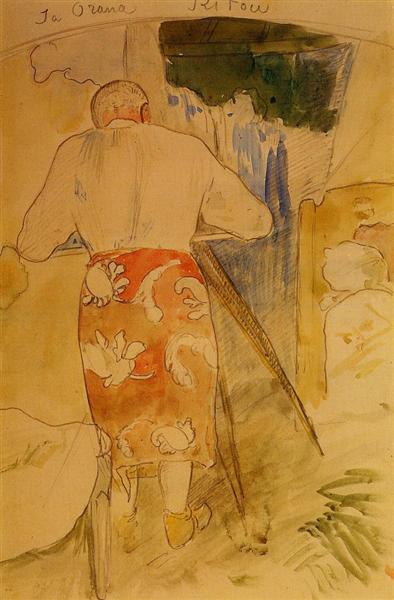Description
In the self -portrait - in the work of 1893, Paul Gauguin offers us an intimate look towards his inner world and the magnitude of his artistic vision. This work is part of the evolution of post -impressionist painting, where color and shape become personal expression vehicles. In this self -portrait, Gauguin combines elements of his daily life as an artist with a vibrant palette that resonates with his search for his own aesthetic language, away from the faithful representation of reality.
The first aspect that stands out in the work is the composition. Gauguin is portrayed in a work environment, a space that seems to be in tune with its dedication to artistic creation. The choice of the background, whose blue and greenish shades contrast with the use of warmer colors in its figure, suggests a balance between introspection and creative energy that emanates from the artistic process. This colored contrast, characteristic of Gauguin's style, not only establishes a dialogue between the subject and the surrounding space, but also reflects the emotional temperament of the artist, rooted in an exploration of spirituality and nature.
The use of color in this work is particularly remarkable. Gauguin chooses an intense palette, where the tones are saturated and expressive, something that distinguishes him from his contemporaries. On his face, with all his nuances and shadows, we can see the traces of experience and suffering, but also the determination of a creator who has decided to immerse himself in his work with passion. This duality can be interpreted as a reflection of the internal struggle that Gauguin experienced, between his artistic ambition and the difficulties of everyday life. The brushstroke and often almost emotional highlights this conflict, taking the viewer to a direct connection with the author's emotional state.
Although other characters are observed in self -portrait, the presence of the environment feels almost like a protagonist in their own right. The paseada work table with art tools and materials suggests a space where ideas take shape, while the colors applied to their instruments indicate both an operational method and a meditation on the creative process. This approach in "work" invites us to reflect on the nature of artistic creation and the commitment that entails.
This self -portrait is also a testimony to Gauguin's development as an artist, near his explorations in Polynesia that would define much of his legacy. At that time, Gauguin was still clinging to the aesthetics of the beginnings of post -impressionism, but began to outline the path to a bold and symbolic use of color. His work in this period presents a strong influence of symbolist philosophy, which seeks to explore the intangible through visual representation.
The importance of this work lies, therefore, not only in its aesthetic value, but also in what it represents: a moment of search and discovery, in which Gauguin undertakes not only to the creation of his art, but also to a trip towards his own self. Where others undermine the detail in favor of the pure form, Gauguin chooses to portray its occupation with an approach that resonates with a type of vulnerability. Thus, self -portrait - at work it is not simply a job on the technique of painting, but an exploration of the identity of the artist and its deep connection with the act of creation itself.
KUADROS ©, a famous paint on your wall.
Hand-made oil painting reproductions, with the quality of professional artists and the distinctive seal of KUADROS ©.
Reproduction service paintings With a guarantee of satisfaction. If you are not completely satisfied with the replica of your painting, we refund your money 100%.

